What's the difference between Panama Donkey Manor and mule Manor? Introduction to Panamanian Pocket Coffee
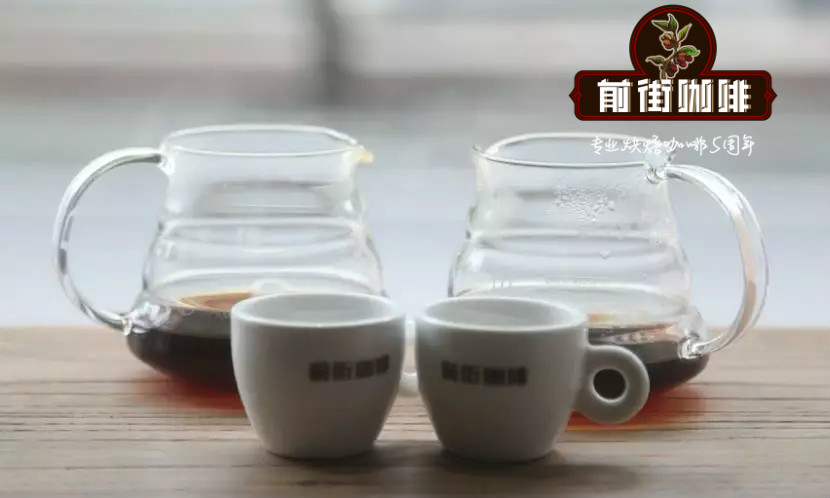
Professional coffee knowledge exchange more coffee bean information please follow the coffee workshop (Wechat official account cafe_style)
| 01 | introduction |
Panama mule manor La Mula
In the Poquet region of Chiriki province in Panama, both are located in Portrerillos, the southern slope of Mount Baru. About 1700-1800 meters above sea level, the terrain of the area is steep, there are a large number of native tree species as shade trees, and clouds wrap around, effectively prolonging the growth cycle of coffee. The soil is volcanic soil with high content of potassium and phosphorus and rich organic matter.
Donkey Manor has a history of nearly 100 years, because the original location of the manor is livestock farming, so the owner of the El Burro after growing coffee named it after donkey. The varieties grown at Donkey Manor include Rosa and Kaduai, and coffee cherries are processed at Arida Manor (the same owner). On the other hand, the mule manor grows only Rosa, while coffee cherries are transported to a nearby processing plant for processing.
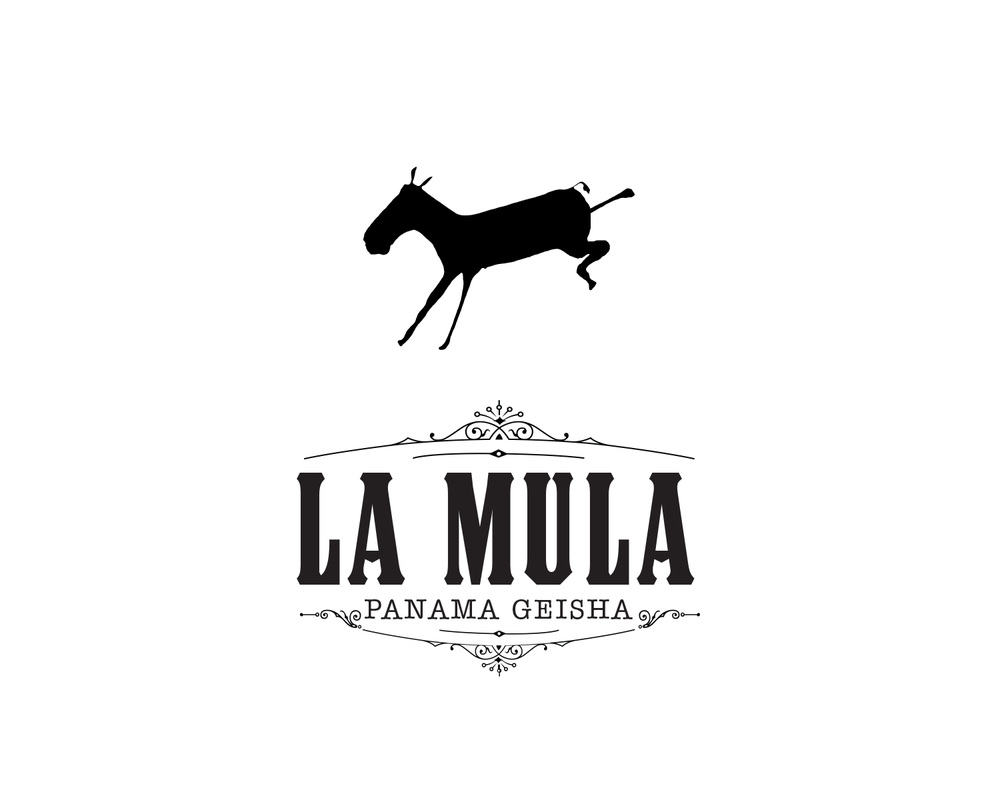
The mule estate was bought by William Bout in 2005 and has been growing coffee since 2007. He said that when he first went to the manor, he went by La Mula because it was named the mule manor.
As two coffees with the same growing environment and different treatments, their flavors also have their own advantages. Donkey manor has more choices in variety and treatment, and mule manor is characterized by sun treatment of rose summer.
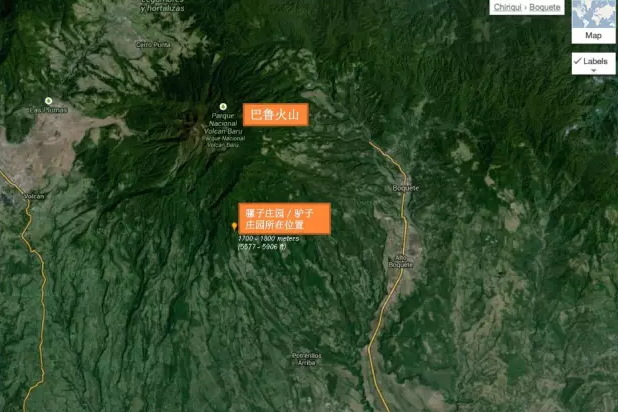
History of mule manor
Mr. Willem Boot said he had the privilege of tasting the rosy summer of 2004 when it was first presented in the best Panamanian raw bean competition. After he discovered Rose Summer, a Panamanian landowner, Graciano Cruz, contacted him. The landowner told him that there was a special piece of land on the hillside of Mount Baru. The elevation of more than 1700 meters, coupled with the beautiful valley south of Poquet, gives Mr Willem Boot plenty of reason to believe that the land will make his dream come true. The land was renamed "mule manor" and 6000 coffee trees were planted on the steep, wooded hillside of the new Rosa Manor.
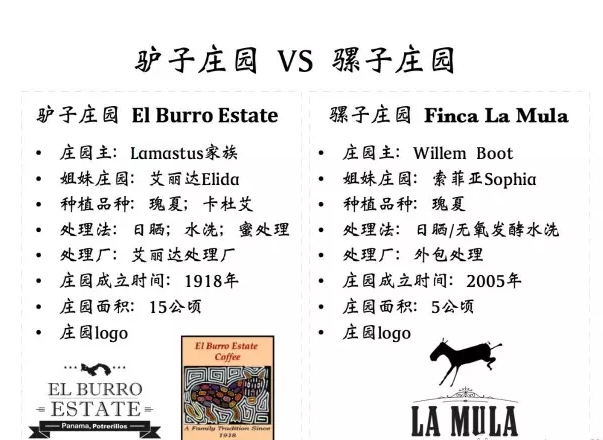
The planting of young rosy summer coffee trees poses a great challenge for the 15-member aboriginal Ngbe-Bugl é workers. At the beginning of the 19th century, the Indian population was indispensable to Panamanian coffee culture. They perform almost all the important farming tasks, from weed pruning and management to fertilizing coffee trees to picking ripe coffee cherries. Sowing and planting coffee is the hardest work that requires the most manual labor. Especially in the mule manor, where there is no regular road, all coffee seedlings have to be transported manually and walk through the winding steep forest path.
Brief introduction of Manor
The mule estate, owned by Mr. Willem Boot, is a small coffee farm focused on micro-batch production. Mule Manor cultivation began in 2007 and is made up of a team of 15 trained aboriginal coffee growers. The coffee training institute was founded by Graciano Cruz, the owner of a Panamanian coffee farm. Courses include coffee cultivation, harvesting, processing and cup testing. The mule manor's planting concept is also part of the school's courses, and the training focuses on coffee growing techniques such as the environmental sustainability of high-altitude coffee.
Mule Manor is located on the southern slope of the Walken Mountains in Chiriki province, Panama, at an altitude of 5575 to 5906 feet. The farm covers an area of 5 hectares, including about 6000 Rosa coffee trees. Among the Rosa varieties grown on the farm, three Rosa varieties have been found, including green top and copper top, as well as a natural variant hybrid dwarf variety. The estate has two full-time coffee farmers and lives in an environmentally friendly house built by the owner, Mr. Willem Boot. As the manor is located at high altitude, in order to provide a comfortable living environment for employees, the shell of the house is made of cold and moisture. In order to reduce the smoke inhaled by employees and create a natural living environment, the staff residence uses O'Neill 's environmentally friendly cooking stove. 1/5 acres of land on the estate is used for the daily consumption of beans and vegetables for father and son of full-time employees.
Where did the mule manor get its name?
Mr. Willem Boot rode a mule when he first visited the manor!
Sustainable development operation
Mule Manor is a small manor that adopts a sustainable mode of operation and will ensure as little loss as possible. Local environmental protection policies do not allow the use of insecticidal water and pesticides. Fungicides are also rarely used, only when fungi are seriously attacked. The use of fertilizers will be used strategically to ensure the nutrients needed by the soil, and the mule manor itself is in a high-altitude, tropical rainforest environment. The owner of the mule estate hopes to live in harmony with the natural environment, which is covered with middle-aged and elderly trees, as well as a large number of mammals (including the occasional cheetah) and a wide variety of insects.
The cloudy forest attracts at least 200 species of migratory birds and provides natural shade for coffee trees. These shade trees not only keep the soil moist, lower the annual average temperature, ensure the longer growth time of coffee cherries, and do not need artificial irrigation.
The soil of the manor contains a lot of organic matter and is surrounded by unspoiled forests. Mule Manor is involved in an environmental protection program about local water conservation, and the beans from the mule manor are sent to the nearby Hartman Manor treatment plant for disposal. Plastic and waste are collected at the manor and transported to the recycling or waste collection area. A path has been built in the manor, and a local tree species with well-developed roots, "mirto", has been planted to one side to effectively prevent soil erosion.
The mule estate pays its workers well, far higher than the local minimum wage in Panama, guaranteeing them access to health insurance and other social benefits. Two coffee farmers who have lived on the estate for a long time will also enjoy free food and additional health benefits. Medical services will also be provided according to the needs of workers.
The manor presents a new generation of non-traditional coffee entrepreneurs in order to produce the highest quality coffee, extending vertically to the manor in the industrial chain. In the case of the mule manor, the landowner provided more personal benefits to the farm workers than traditional farmers.
This year, Grand Cru Coffee traveled to Panama as early as March and selected two varieties and three treatments of the donkey farm, a total of four batches (Kaduai is only sun-treated), as well as the most popular sunburn batch of tropical fruit in the mule estate. Try the beans of two BOP Changsheng manors at the same time, it is sure to let everyone know these two manors better.
Part of the award won by the mule manor
Best Panamanian (BOP) tanning group champion of 2014
2015 Coffee Review score 97 points, annual champion
2016 Good Food Award
MICE Gold Award & Silver Award in 2017 Australian Coffee Competition
Beans for the champion of the 2017 Ukrainian Coffee Brewing Competition
Cup test flavor record
Blackcurrant, passion fruit, cocoa and jasmine aromas with rich flavors, including caramel with dried papaya, camellia and jasmine flavor
Mr. Willem Boot has been working with Grand Cru Coffee this year, and reservations for Rose Summer at mule Manor and Sofia Manor are now open.
The following is the translation and arrangement authorized by Mr. Willem Boot:
Points for attention in mule rose summer (sun exposure) baking
Rosesia varieties often have their unusual characteristics. Beans are generally longer in shape than other varieties. If you look at the shape of the raw bean from the side, you will see that the shape of the bean is slightly curved, similar to the shape of a canoe. Another feature is that the centerline of the rose beans opens slightly outward, making it easier for heat to infiltrate into the core during baking.
Mule Manor has a higher altitude (about 1700-1800 meters) so that coffee beans have a higher density than other rose summers. Recent measurements show that the density of mule Rosa peas can reach 840kg / m3, which is 5% higher than that of Rosa growing at 1550 meters above sea level, and it is more difficult for heat to enter the bean core. The characteristic of high density brought about by high altitude is contrary to the effect of the extended centerline, which makes baking more complex. The most difficult part is to show the flavor of the flowers. Excessive use of hot air does not help the fragrance of flowers. The more hot air is used, the more time it takes for coffee to develop its floral flavor.
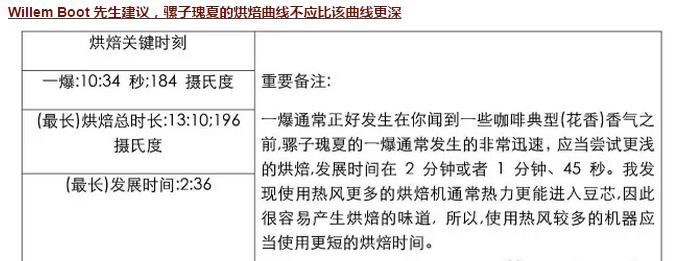
If you use a lot of hot air in your roaster (e.g., Probat, Giesen, Loring) and you can't reduce the proportion of hot air, Mr. Willem Boot recommends keeping the roasted coffee beans in an airtight container or bag for at least 72 hours before drinking.
If you use less hot air in your roaster, you may be allowed to control or reduce the proportion of hot air, so that the floral flavor can be displayed after 24 hours of baking.
The next content includes the data recorded by Mr. Willem Boot and others in San Francisco. The temperature of entering beans needs to be lower than that of other beans, and the gas valve is set to "5", which represents the use of 70% firepower and 70% capacity of the roaster. If you use less beans, please reduce your firepower accordingly. Please note that the development time (RD) should not be up to 2 minutes and 36 seconds!
Beans, winner of the 2016 Japanese barista contest
Country of origin: Panama
Producing area: Pokuit
Manor: donkey Manor
Treatment: washing treatment
Altitude: 1750-1850 m
Variety: Geisha
Picking date: may 2017
Aroma: Cherry, strawberry, watermelon, jasmine
Flavor description: Cherry, watermelon, plum, lemon, lasting jasmine tea tail
Compared with the famous Emerald Manor, the Donkey Manor with low yield is more mysterious. The Donkey Manor, located in the Pokuit region of Panama, is located on the south slope of the Baru volcano, with fertile soil rich in organic matter, high altitude and steep topography, and shrouded in clouds all the year round. created the unique local characteristics of the manor coffee. Although the name of the manor is very approachable, the coffee it breeds is good. In recent years, Donkey Manor has won many successes in the Best Panama Competition (BOP) and gained fame.
Suzuki Suzuki, a coffee barista from Maruyama, Japan, won the Japanese barista contest (2016JBC) in 2016 with this washed rose summer at Donkey Manor.
Qianjie coffee is recommended to use V60 filter cup, water temperature 90 ℃, powder / water ratio 1:15, medium and fine grinding, extraction time 2 minutes ~
Important Notice :
前街咖啡 FrontStreet Coffee has moved to new addredd:
FrontStreet Coffee Address: 315,Donghua East Road,GuangZhou
Tel:020 38364473
- Prev
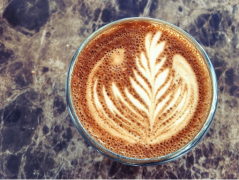
Costa Rica three Sister Manor Kaddura seed Honey treatment Fine Coffee Raw Bean Flavor
For the exchange of professional baristas, please follow the coffee workshop (Wechat official account cafe_style) Tres Hermanas Estate Caturra Honey Costa Rica three Sisters Manor single Kaddura honey treatment flavor description: dry aroma with spice and a hint of freshly ground sesame. The orange is the main tone after the entrance, the aroma of caramel and the fine sweet taste of jujube
- Next

Introduction of fine coffee beans by Kaddura wine-scented sun treatment in Costa Rica's three Sister Manor
Professional baristas please follow the coffee workshop (Wechat official account cafe_style) Tres Hermanas Estate Caturra Winey Costa Rica three Sisters Manor single Kaddura wine sun treatment flavor description: sun fruit is sweet but also wine mellow. After the entrance, you can feel the warm aroma of tropical fruit wine, with passion fruit in the middle,
Related
- Detailed explanation of Jadeite planting Land in Panamanian Jadeite Manor introduction to the grading system of Jadeite competitive bidding, Red bid, Green bid and Rose Summer
- Story of Coffee planting in Brenka region of Costa Rica Stonehenge Manor anaerobic heavy honey treatment of flavor mouth
- What's on the barrel of Blue Mountain Coffee beans?
- Can American coffee also pull flowers? How to use hot American style to pull out a good-looking pattern?
- Can you make a cold extract with coffee beans? What is the right proportion for cold-extracted coffee formula?
- Indonesian PWN Gold Mandrine Coffee Origin Features Flavor How to Chong? Mandolin coffee is American.
- A brief introduction to the flavor characteristics of Brazilian yellow bourbon coffee beans
- What is the effect of different water quality on the flavor of cold-extracted coffee? What kind of water is best for brewing coffee?
- Why do you think of Rose Summer whenever you mention Panamanian coffee?
- Introduction to the characteristics of authentic blue mountain coffee bean producing areas? What is the CIB Coffee Authority in Jamaica?

